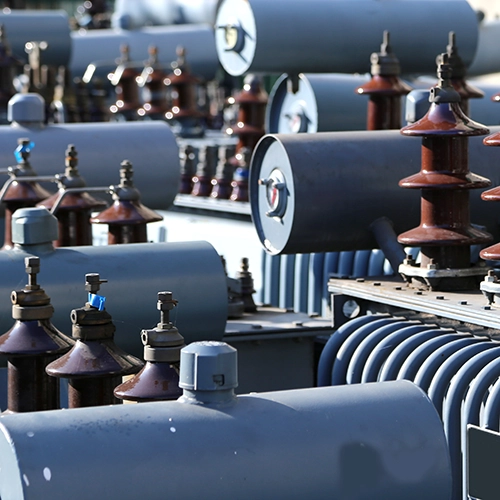Halogenated Organic Compound Analysis You Can Trust
As the largest American-owned environmental laboratory network, Pace® provides a wide range of environmental testing services for many types of clients. Testing for total organic halogens (TOX analysis), extractable organic halides (EOX), and adsorbable organic halogens (AOX) in groundwater, used oil, and soil helps our customers mitigate environmental risks and comply with regulations and industry standards.
Our innovations laboratory is at the forefront of developing test methods that make testing for halogenated organic compounds faster, easier, and more reliable for our customers. Reach out to a Pace® representative to discuss your project today.

What Are Organic Halogens?
Organic halogens, sometimes referred to as organohalogen compounds or organic halides, are a category of organic compounds that include at least one halogen atom (fluorine [F], chlorine [Cl], bromine [Br], or iodine [I]) bonded to carbon.
Not all organic halogens are considered pollutants, but some can be toxic. For example, organochlorine pesticides, a subcategory of organic halogens, are known pollutants that have caused significant environmental and health concerns. Similarly, other organic halogens, such as polychlorinated biphenyls (PCBs) and brominated flame retardants, are also considered hazardous. These pollutants can be resistant to degradation and easily transported by wind and water.
Common Organic Halogens
Chloroform (CHCl₃) is a common laboratory solvent, historically used as an anesthetic.
Once extensively used as an insecticide, DDT use is now restricted due to environmental concerns.
The CCL is a list of contaminants not currently subject to any proposed or promulgated national primary drinking water regulations but are known or anticipated to occur in public water systems. The Safe Drinking Water Act (SDWA) requires USEPA to publish a new CCL every five years, and this list often provides insights into which compounds EPA is considering for future rulemaking.
Bromoxynil (HOBr2C6H2CN) is one example of an organic halogen found on CCL 5. This compound is a broad-spectrum herbicide used for post-emergence control of annual and perennial broadleaf weeds. Drafting for CCL 6 is underway and expected to include many additional organic halogens, particularly in the per- and polyfluorinated substances (PFAS) category.
PVC is a polymer used for a wide variety of purposes, including pipes and vinyl siding.
Also known as perchloroethylene, or perc, tetrachloroethylene (C₂Cl₄) is commonly used in the dry-cleaning industry.
Trichloroethylene (C₂HCl₃) is used as an industrial solvent.
Used in coolants, insulating materials, and lubricants, PCBs are now banned due to their environmental persistence and toxicity.
PFAS include 5000+ synthetic chemicals widely used in industry and consumer products since the 1950s.

How Are Organic Halogens Regulated?
Organic halogens cover a wide range of chemical compounds, so the number of regulatory programs with which Pace® clients must comply is extensive. Here are a few that may call for an analysis of organic halides.

CERCLA, also known as Superfund, gives the EPA broad authority to respond directly to actual or threatened releases of hazardous substances. Once a compound is designated hazardous under CERCLA, the EPA has the authority to respond directly, e.g., issue cleanup orders in the event of a release or existing contamination.
In the United States, RCRA is the primary federal law governing the disposal of solid and hazardous waste, including organic halogens. Enacted in 1976, RCRA grants the EPA the authority to regulate hazardous wastes from cradle to grave, including generation, transportation, treatment, storage, and disposal.
The CCL is a list of contaminants not currently subject to any proposed or promulgated national primary drinking water regulations but are known or anticipated to occur in public water systems. The Safe Drinking Water Act (SDWA) requires USEPA to publish a new CCL every five years, and this list often provides insights into which compounds EPA is considering for future rulemaking.
Bromoxynil (HOBr2C6H2CN) is one example of an organic halogen found on CCL 5. This compound is a broad-spectrum herbicide used for post-emergence control of annual and perennial broadleaf weeds. Drafting for CCL 6 is underway and expected to include many additional organic halogens, particularly in the per- and polyfluorinated substances (PFAS) category.
As described by the EPA, ELGs (Effluent Limitations Guidelines) are “national, technology-based regulations developed to control industrial wastewater discharges to surface waters and into publicly owned treatment works.”
These guidelines cover a wide array of industries, but Organic Chemicals, Plastics and Synthetic Fibers (OCPSF) is one that can be particularly impacted by ELGs on organic halogens. For example, hexafluoropropylene (HFP) is used to create polyvinylidene fluoride (PVDF) fibers with an exceptional resistance to chemicals, wear, and environmental degradation. PVDF fibers are also used in other applications such as filtration, piezoelectric devices, and architectural membrane structures.
Created in 1972 by the Clean Water Act (CWA), NPDES is a permitting program designed to regulate the discharge of pollutants into the waters of the U.S. (WOTUS). States can petition the EPA to administer their own NPDES program, and most states have received partial or full approval. Due to their widespread use, testing for organic halogens is frequently required for NPDES permitting.
Enacted in 1974, the SDWA grants the EPA the authority to set National Primary Drinking Water Regulations (NPDWRs). For example, trichloroethylene (TCE) is an organochloride compound widely used in industry, primarily as a solvent to remove grease from metal parts.
Per the EPA’s NPDWR, the Maximum Contaminant Level (MCL) – the highest contaminant allowed in drinking water – for TCE is 5 parts per billion (ppb). In 2023, the EPA also proposed NPDWRs for six PFAS: PFOA, PFOS, PFBS, PFNA, PFHxS, and GenX Chemicals (HFPO-DA). States may set their own MCLs for drinking water contaminants, but they may not exceed the EPA’s NPDWRs.
Created in 1986 under the Emergency Planning and Community Right-to-Know Act (EPCRA), TRI tracks toxic chemical releases from industrial facilities into the environment. Vinyl Chloride, an organochloride compound primarily used to synthesize polyvinyl chloride (PVC), is a well-known example of an organic halogen covered by TRI.
The TSCA grants the EPA the authority to establish reporting, record-keeping, and testing requirements for chemical compounds. Under the authority granted to the agency by the TSCA, PFAS manufacturers are expected to fund PFAS toxicity studies, and the EPA has begun issuing testing orders to industry.
Who We Serve
Landfills
As part of RCRA compliance, landfills must fulfill stringent design, operation, closure, and post-closure requirements. Waste characterization helps ensure the landfill does not accept any waste it is not designed to handle. Groundwater monitoring for total organic halogens can also help ensure hazardous materials have not escaped from an active landfill and that decommissioned landfills are appropriately managed.
Construction
A TOX analysis on construction sites where hazardous materials may have been used can help determine the presence and levels of these compounds and inform remediation strategies.
Manufacturing
Petroleum products used in manufacturing can become contaminated by organic halogens. Testing for organic halogens can help manufacturers and other industrial clients ensure compliance with regulations like RCRA.
Additional Resources
Need to find a lab that can handle your unique requirements?
Contact us directly or download our list of environmental certifications across our network.